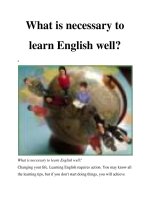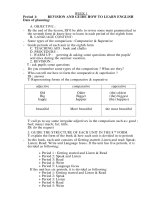REVISION AND GUIDE HOW TO LEARN ENGLISH pdf
Bạn đang xem bản rút gọn của tài liệu. Xem và tải ngay bản đầy đủ của tài liệu tại đây (48.51 KB, 4 trang )
Week 1
Period 1: Revision and guide how to learn English
Date of planning:
A. Objective :
-
By the end of the lesson, SS’ll be able to revise some main grammatical in
the seventh form & know how to learn in each period of the eighth form
B. language content:
-
Some types of the comparison : Comparative & Superative
-
Guide periods of each unit in the eighth form
C. Teaching aid : book and chalks
D. PROCEDURE :
1. Warm up : greeting & asking some questions about the pupils’
activities during the summer vacation.
2. Revision :
T : ask pupils some questions
-
Do you remember some types of the comparison ? What are they?
-
Who can tell me how to form the comparative & superlative ?
SS : answer
T: Representing forms of the comparative & superative
adjective comparative superative
Old
Big
happy
Older
Bigger
happier
(the) oldest
(the) biggest
(the) happiest
beautiful More beautiful the most beautiful
T: call ps to say some irregular adjectives in the comparison such as: good ;
bad; many/ much; far; little.
SS: do the request
3. guide the structure of each unit in the 8
th
form
T: explain the form of the book & how each unit is devided in to periods
-
In this book, each unit consists of Getting started; Listen and read; Speak;
Listen; Read; Write and Language focus. If the unit has five periods, it is
devided as following:
+ Period 1 : Getting started and Listen & Read
+ Period 2: Speak and Listen
+ Period 3: Read
+ Period 4: Write
+ Period 5: Language focus
If the unit has six periods, it is devided as following:
+ Period 1: Getting started and Listen & Read
+ Period 2: Speak
+ Period 3: Listen
+ Period 4: Read
+ Period 5: Write
+ Period 6: Language focus
4. Production:
T: call some ps to go to the board and write some sentences, using the
comparison
SS: do as the request
5. home assignment:
T: revise the main grammar you have learned and prepare the first period
of Unit one : Getting started and Listen & Read
e. remark:
Period 2: unit 1: my friends
lesson 1: geting started & listen and read
Date of planning:
a. Objective :
-
By the end of the lesson, SS’ll be able to revise how to express their daily
activities and learn some new sentences
b. language content:
-
Answer the question “ What do you do everyday? ” & “ What are they
doing? ”
-
Get to know the sentence: “ (not) adj + enough + to-infinitive” and “ What
does she/ he look like?”
c. Teaching aid : book, pictures, stereo and chalks
d. PROCEDURE :
1. Warm up : greeting & asking some questions about the pupils’
friends such as: Do you have any close friends? Who is she/ he ? How old
is she/ he? Where does she/ he live ? What do you often do with her/ him?
2. presentation:
“ GETTING STARTED”
T: give some questios about the pupils’ daily activities such as:
-
What do you often do in your free time?
-
Who do you often play with?
T: call some pairs to ask and answer as above
SS: do as the request
T: show the pictures in the book and ask:
-
What are these children doing?
-
Where are they playing ?
-
What time of the the day do you think it is?.etc
SS: look at the pictures and answer the questions.
T: call some ps to ask & anwer about the pictures and about themselves
“ LISTEN AND READ”
T: give some questions about Hoa: look at the picture and answer
-
Who is Hoa? Where is she from ? How old is she ? Where does she live
now? What class is she in?
SS: listen and answer
T: introduce the situation of the dialogue “ this dialogue is between Hoa &
Lan. Hoa is talking to Lan about her friend in Hue. She is Nien”. Then play
the stereo so as for ss to listen to the whole dialogue.
SS: listen to the dialogue
T: play the tape again , sentence by sentence.
SS: listen and repeat
T: show the new sentences on the board with meaning explanation:
+ What does she look like?
+ She wasn’t old enough to be in my class.
+ What a lovely smile!
3. practice:
T: play the tape again so as for ss to listen again.
SS: listen carefully
T: ask ss to think to answer the questions about the dialogue in pair.
SS: think to answer
T: call some pairs to ask and answer. Others remark.
SS: work in pair befoer the class
T: give correct answers
SS: write down.
T: call some pairs to practise the dialogue
SS: do as the request
4. Production:
T: call ss to retell something about Hoa’s friend, Nien
SS: volunteer to do
T: call ss to say the meaning of the neww sentences given above
SS: do as the request
5. home assignment:
T: learn the new sentence by heart a nd practise the dialogue at home.
Prepair the next lesson “ Speak and Listen”
e. remark:
Period 3: unit 1: my friends
lesson 2: speak & listen
Date of planning:
a. Objective :
-
By the end of the lesson, SS’ll be able to describe a person and remember
how to greet each other when meeting again
language content:
c. Teaching aid : book, pictures, stereo and chalks
d. PROCEDURE :
1. Warm up : greeting & asking some questions about the pupils’
friends such as: Do you have any close friends? Who is she/ he ? How old
is she/ he? Where does she/ he live ? What do you often do with her/ him?
2. presentation:
“ GETTING STARTED”
T: give some questios about the pupils’ daily activities such as:
-
What do you often do in your free time?
-
Who do you often play with?
T: call some pairs to ask and answer as above
SS: do as the request
T: show the pictures in the book and ask:
-
What are these children doing?
-
Where are they playing ?
-
What time of the the day do you think it is?.etc
SS: look at the pictures and answer the questions.
T: call some ps to ask & anwer about the pictures and about themselves
“ LISTEN AND READ”
T: give some questions about Hoa: look at the picture and answer
-
Who is Hoa? Where is she from ? How old is she ? Where does she live
now? What class is she in?
SS: listen and answer
T: introduce the situation of the dialogue “ this dialogue is between Hoa &
Lan. Hoa is talking to Lan about her friend in Hue. She is Nien”. Then play
the stereo so as for ss to listen to the whole dialogue.
SS: listen to the dialogue
T: play the tape again , sentence by sentence.
SS: listen and repeat
T: show the new sentences on the board with meaning explanation:
+ What does she look like?
+ She wasn’t old enough to be in my class.
+ What a lovely smile!
3. practice:
T: play the tape again so as for ss to listen again.
SS: listen carefully
T: ask ss to think to answer the questions about the dialogue in pair.
SS: think to answer
T: call some pairs to ask and answer. Others remark.
SS: work in pair befoer the class
T: give correct answers
SS: write down.
T: call some pairs to practise the dialogue
SS: do as the request
4. Production:
T: call ss to retell something about Hoa’s friend, Nien
SS: volunteer to do
T: call ss to say the meaning of the neww sentences given above
SS: do as the request
5. home assignment:
T: learn the new sentence by heart a nd practise the dialogue at home.
Prepair the next lesson “ Speak and Listen”
e. remark:









